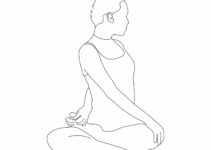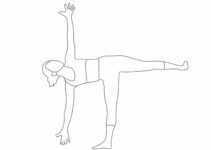What is the meaning of Shankhaprakshalana?
Shankhaprakshalana comprises two words: Shankha conch and Prakshalana means cleaning out. Shankha is used for the intestine as passage through the intestines is as tortuous as the passage of a conch. Thus, Shankhaprakshalana means washing or cleansing of intestines. In Shankhaprakshalana, the water is made to pass through the intestines with the help of specific exercises and cleans all impurities of the intestines. Here, we will discuss Shankhaprakshalana’s easy steps, wonder benefits and the contraindications it has while practising.

Preparations
The water used for this practice should be lukewarm, a few degrees warmer than the water used for the Kunjal shatkarma process. An adequate quantity of salt should be used to make it more alkaline.
How to do Shankhaprakshalana step by step
Sit in Kagasana and take at least three glasses of lukewarm salty water. The text of Haṭharatnavali mentions the use of water sweetened with jaggery, coconut water or milk water instead of salty water (1/50) taken up to the neck and retaining the water and air both according to the strength.
- Immediately after taking water, perform a series of the following four yoga poses in the order given here:
- Sarpasana
- Hastottanasana
- Kaṭicakrasana
- Udarakarṣaṇasana
- While performing above yogasanas, bend four times to the right and four times to the left in each yoga pose.
- Again, take a fresh glass of water and repeat all four asanas individually. The quantity of water to be consumed varies from individual to individual.
- As soon as there is a sensation to pass stool, go to the toilet and clear the bowel. This will ensure evacuation first of solid stools, then of semi-solid stools and finally of yellowish water. After this, take a fresh glass of water and repeat these four yoga poses rapidly. This time, only liquid will be ejected by the bowels. Continue to take water and repeat the asanas till clear water is evacuated.
- At the end, take two or three glasses of ordinary lukewarm water without any salt and perform the Kunjal; otherwise, water will continue to be discharged from the rectum for a long time.
Shankhaprakshalana contraindications
- After performing this yogic process, always use warm water for baths. Never use cold water.
- The body must be covered with clothes before leaving the bathroom. Avoid exposing the body to cold air.
- Do not keep the stomach empty for a long time after completing the practice of Shankhaprakshalana.
- Do take the prescribed meal within an hour of finishing the whole process. It is advised to take Khichari (a liquid mixture of cooked rice, moong dal and ghee).
- Avoid taking pepper, vinegar and sour things.
- Milk and curd must not be taken twenty-four hours after performing this Shankhaprakshalana.
- It should be practised under the guidance of trained Yoga expert.
- Shankhaprakshalana should not be performed during extremely cold or cloudy days.
- People suffering from high blood pressure, hernia, epilepsy, heart diseases and piles should not practise this Kriya.
Six excellent benefits of Shankhaprakshalana
- Shankhaprakshalana is much more effective in purifying the digestive system.
- This yogic process supports the normal functioning of the intestines and relieves flatulence, constipation, acidity, indigestion, menstrual cramps, asthma, acne boils, etc.
- It also prevents urinary infections and the formation of kidney stones.
- The addition of fasting or partial fasting enhances the benefits of the practice. It counteracts the bowel malfunctions that cause a decrease in the natural cleansing of the intestines due to low-grade food, a sedentary lifestyle, or gradual organic breakdown. It benefits the extreme cases where the tract could be like a pipe clogged up by limescale.
- The purification of the body through the Shankhaprakshalana sharpens the mind and creates dynamic vitality.
- It facilitates performing advanced and intensive yogic practices, leading to a higher state of awareness.
Shankhaprakshalana Yoga poses
How to do Sarpasana (Snake Posture) step by step
- Take a prone lying position, legs and feet together, toes pointing outward, hands by the side of the body, fingers together, palms facing upward, and forehead resting on the ground.
- Fold hands at the elbows and place palms on the ground by the sides of the shoulders in a way that thumbs are under the armpits.
- Bring chin forward and place it on the ground; gaze in front.
- Raise chin and turn head backwards as much as possible. Raise the thorax, turning supine backwards up to the navel. Do not raise your navel.
- Maintain the posture for a little while. Then, slowly bring the body to the ground – starting from the upper part of the navel region, thorax, shoulder, chin, and lastly place the forehead on the floor.
- Now, relax the hands and place them by either side of the thighs.
Hastottanasana (Up-Stretched Arms Posture) easy steps
- Stand on the ground with feet joined together.
- Raise the arms and interlock the fingers of the hands.
- In one smooth movement, looking straight ahead, drop down to the left, bending from the waist, and try to get lower enough for the arms to be parallel with the floor.
- Come back to the centre and repeat on the right side.
How to do Kaṭicakrasana (Lumbar-Wheel Posture) step by step
- Standing firmly on the ground, move the legs apart not more than the shoulders’ length.
- Now, keep the arms outstretched in front of the chest. Swing the arms slowly towards the right side of the body.
- Try to take the arms backwards as far as possible, twisting the body from the waist, and keep the feet firm on the ground.
- Repeat the same procedure towards the left side.
- Remember, the arm towards which the body is swinging should be kept straight while the other arm should be bent.
How to do Udaraakarṣaṇasana step by step
- Sit in Kagasana.
- Keep the distance of a hand span between the feet.
- Keeping the hands on the knees, push the right knee with the right hand close to the left foot, about an inch above the ground.
- Repeat it with a similar movement of the left knee towards the right foot.






Please put the picture of the 4 Asanas…